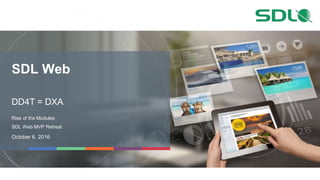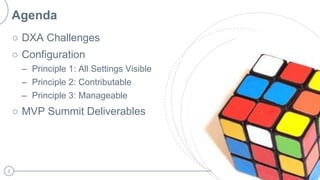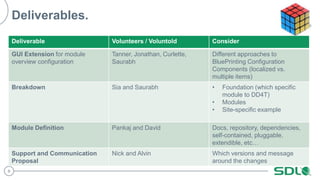SDL Web DXA: A Vision for Modules
- 1. SDL Web DD4T = DXA Rise of the Modules SDL Web MVP Retreat October 6, 2016
- 2. 2 Image placeholder Click on image icon Browse to image you want to add to slide Agenda ŌŚŗ DXA Challenges ŌŚŗ Configuration ŌĆō Principle 1: All Settings Visible ŌĆō Principle 2: Contributable ŌĆō Principle 3: Manageable ŌŚŗ MVP Summit Deliverables
- 3. 3 Configuration Challenges with DXA ŌŚŗ In the 5 Stages of Tridion Knowledge* ŌĆō What modules are available? ŌĆō What can I configure in a module? ŌŚŗ In implementations ŌĆō WhatŌĆÖs set up in a specific system? ŌĆō I want some parts of DXA, but not all of it ŌŚŗ In demos ŌĆō Is it supported? ŌĆō Can I see a demo specific to my industryŌĆÖs needs? ŌĆō I want to manage my own favorite example sites * https://prezi.com/fmxykjxu16y_/5-stages-of-grief-with-sdltridion-knowledge/ Action Mihai on a serious project
- 4. 4 Configuration isnŌĆÖt just about configuring modules. Configuration is about discoverability, contributions, and the adoption of modules.
- 5. 3 principles: discoverable, contributable, and manageable
- 6. 6 Principle 1: Discoverable ŌĆ£As an implementer, I want to know what I can configure within a given system quickly.ŌĆØ This can include: ŌŚŗ All modules visible from a single screen ŌŚŗ Settings within 1-2 clicks away ŌŚŗ Per-Publication settings easily reachable ŌŚŗ Custom module editors ŌŚŗ Searchable settings ŌŚŗ ŌĆ£AutomaticŌĆØ documentation Example: Chrome settings in 3 tabs Example: Searchable settings in chrome
- 7. 7 Principle 2: Contributable As an implementer or customer, I want to find, learn about, and contribute to individual modules easily. This can include: Example: SDL AppStore (Language Apps) Example: Alchemy Webstore A standard definition Locations to get modules such as ŌĆó Name ŌĆó Description ŌĆó Metadata ŌĆó Code repository ŌĆó Version number ŌĆó Dependencies ŌĆó Author(s) ŌĆó Etc ŌĆó Alchemy Webstore ŌĆó NuGet and Maven ŌĆó SDL Community ŌĆó Partner sites
- 8. 8 Principle 3: Manageable Modules ŌĆ£As an implementer I want a way to: ŌĆó Install ŌĆó Deploy ŌĆó Maybe enable/ disable individual modulesŌĆØ This should work across DTAP (dev, test, acceptance, and production) in load balance scenarios with multiple Content Delivery environments. Example: Chrome extensions enabled-status toggle
- 9. 9 Deliverables. Deliverable Volunteers / Voluntold Consider GUI Extension for module overview configuration Tanner, Jonathan, Curlette, Saurabh Different approaches to BluePrinting Configuration Components (localized vs. multiple items) Breakdown Sia and Saurabh ŌĆó Foundation (which specific module to DD4T) ŌĆó Modules ŌĆó Site-specific example Module Definition Pankaj and David Docs, repository, dependencies, self-contained, pluggable, extendible, etcŌĆ” Support and Communication Proposal Nick and Alvin Which versions and message around the changes
- 10. Copyright ┬® 2008-2014 SDL plc. All rights reserved. All company names, brand names, trademarks, service marks, images and logos are the property of their respective owners. This presentation and its content are SDL confidential unless otherwise specified, and may not be copied, used or distributed except as authorised by SDL. Global Customer Experience Management
- 11. 11 Foundation, Modules, Example Sites Foundation ECommerce Module 1 Module 2 Module n TodayŌĆÖs DXA Module 1 Module 3 Module 4 Foundation











